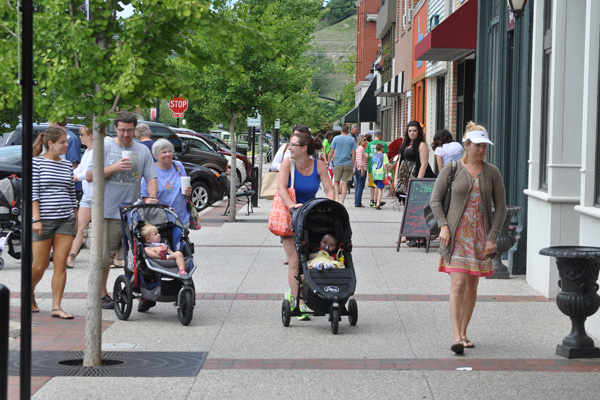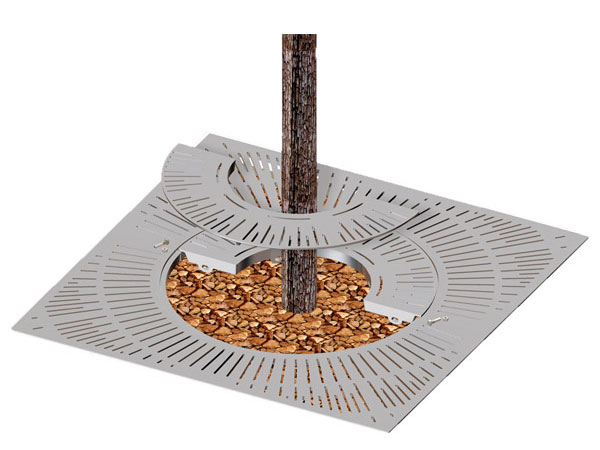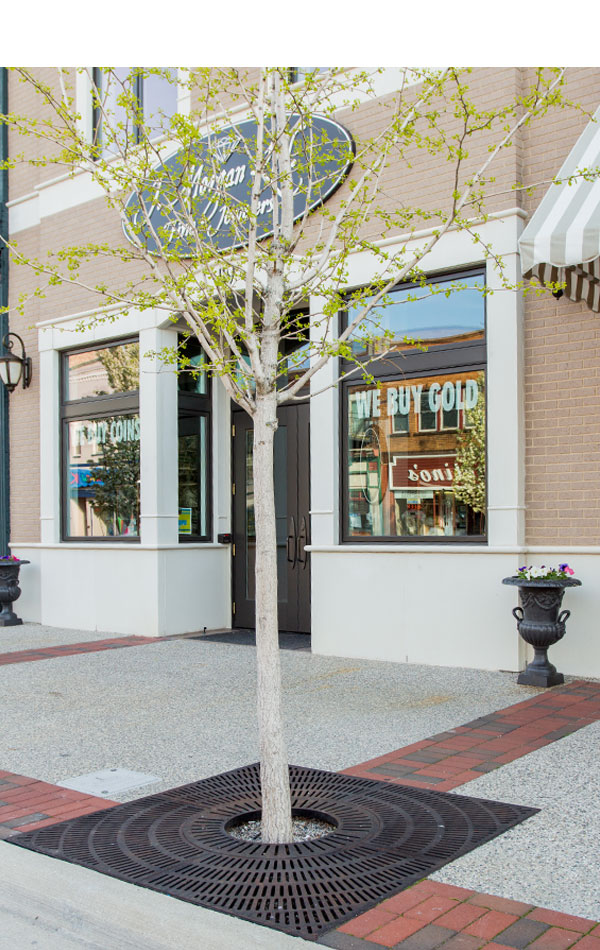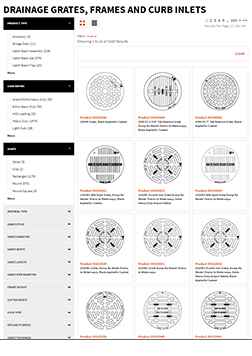A Streetscape Makeover For A Michigan Coast Guard City

Downtown Project Incorporates New Tree Grates, Curb Inlets, Fire Hydrants, and Custom Logo Manhole Covers
With its iconic lighthouse and pier, musical fountain and quaint downtown, Grand Haven has left a beautiful imprint on the memories of millions of vacationers. In 2009, this Coast Guard City began the first of two streetscape transformation phases that would make that imprint even more enduring.
PHASE 1: DOWNTOWN
DESIGN: C2AE
The first phase, started in the fall of 2009 and completed in late 2010, included the three downtown blocks of Washington Avenue that end at the Grand River. It was a complete replacement of “everything from building front to building front,” according to Roger Marks, director of transportation services for C2AE and project manager for the design phase.
The streetscape design, Marks said, “was drawn from a number of different studies that set the project up. And there were a lot of decisions and choices to be made to accommodate all the things that went into it,” such as a hot water snowmelt system. “The goal,” he said, was “to create a setting that offered greater pedestrian mobility and was ADA compliant.”
It also had to maintain the charm of the historic downtown while replacing aging water and sewer infrastructure. While much of the work was underground, the completed streetscape has several distinctive touches which demonstrates the landscape architect’s eye for detail.
Incorporating Long-Term Quality Solutions
Key among these touches are the Nova tree grates that surround dozens of new trees. The grates allow for barrier-free passage close to the trees, maximizing the pedestrian capacity of the sidewalk. They feature centers that can be removed as the trees grow. “These accommodate 30 to 40 years’ worth of tree growth,” said Grand Haven City Manager Pat McGinnis. “We won’t be faced with grates restricting the growth of the trees or eventually killing them.”
New hydrants, access covers, and curb inlets were also installed. “[The products have] a well-earned reputation,” Marks said. “You know you’re going to get quality, and that’s important. You need to leave the city’s maintenance people with something they’re going to be able to take care of.”
The project added several mid-block crosswalks to increase pedestrian mobility. A new wayfinding system features covered, enclosed cases near crosswalks. These contain directions and also serve as a way to post community information.
The downtown project was really two separate projects, according to McGinnis. The utilities, street and streetscaping was a $3 million project, while the snowmelt system was another $3 million. The projects were funded primarily through tax increment financing, along with local sewer and water funds and grants from the Michigan Department of Transportation and the Michigan Department of Environmental Quality.
It’s All About Timing
Timing was the biggest challenge of this ten-month project, said the project’s construction engineer, Timothy J. Hoffert, PE of Moore & Bruggink. “It’s a very high-profile vacation area,” Hoffert said, “and this project was the first three blocks of downtown; a complete streetscape. We tore everything out, water, sewer, sidewalks, storm sewer, and started over.” Crews completed one block in the fall of 2009 and went back to work in the spring of 2010. “We would do one block, then stagger the work up the street. But we couldn’t work during the summer when tourism peaked,” Hoffert said. That made logistics a critical part of the operation. “It was a lot of staging work to get this to all come together,” Marks said.
PHASE II: CENTERTOWN
DESIGN: THE JOHNSON HILL LAND ETHICS STUDIO; FISHBECK, THOMPSON, CARR & HUBER
The Centertown Streetscape project included two blocks of Washington Avenue from the railroad tracks east to Beacon Blvd. (US-31). The $1.1 million project also included replacement of water and sewer infrastructure, new pavement and streetscaping. More than half the cost was covered by a Michigan Economic Development Corporation grant.
This project was the first step in a larger plan developed by The Johnson Hill Land Ethics Studio, a Michigan landscape architecture firm, to bring new life to the Centertown district. The Washington Avenue improvements are critical because these two blocks are the most heavily used gateway for tourists heading to Grand Haven’s downtown.
As such, the plan called for a blend of beauty and durability. The beauty is in the visible elements of the streetscape — tree plantings, decorative planters and lighting, platforms for sculpture and other spaces for public art. Durability is critical in the infrastructure elements: water, sanitary and storm sewers, catch basins and the road surface itself.
Premium and Custom Products by EJ Offer Perfect Solution
The need for the combination of those elements is part of the reason Mark Robinson, PLA, ASLA, principal of Johnson Hill, wrote performance specs specific to EJ products, including custom ones. “I’m a longtime specifier of [premium] products,” he said, “because of both the quality of the product and the service they provide.” That service helped solve one of the project’s biggest ADA challenges: tree grates along the sidewalk.
Robinson also used a different design for sidewalk pavers — one the frames of standard tree grates would not accommodate.
“We had to modify the frame on the grate to accommodate the pavers in a different way,” Robinson said. “[EJ] worked with us to determine how to make that modification, then helped us prepare a detail so paving contractors could bid on it.”
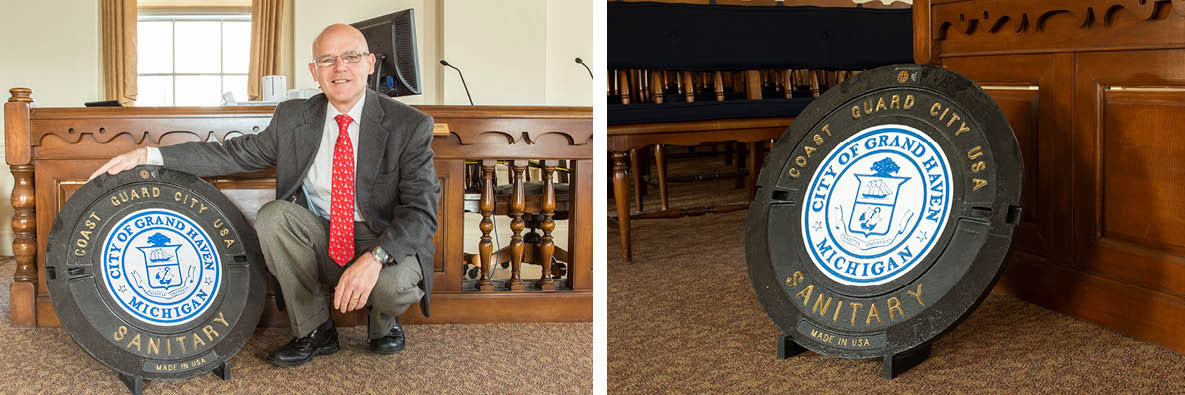
Of the custom touches designed into the Centertown project, the one that had City Manager McGinnis most excited, was the rollout of Grand Haven’s own distinctive manhole covers.
“It’s a custom Grand Haven mold,” he said, “Grand Haven originals. They have the city seal on them. This is the first time we spec’d out a custom one, and we’ll be using them in all new projects from now on…We had to cut out a few other bells and whistles to be able to produce these,” McGinnis said, “but the long-term benefit can’t be measured.”
One of the first covers off the line, in fact, has already become an attraction. “Someone took one and had it decoratively painted,” McGinnis said. The city presented the painted cover to the Coast Guard, and it is currently on display in the lobby of Coast Guard Station Grand Haven.
Nearly A Decade Later, Downtown Still Looks Great
Now years since the project has been completed, it’s obvious that the right products were chosen for the job.
“The people working [at the city] now are very proud of the downtown area, and are very loyal EJ people,” said Mike Vander Molen, EJ Sales Representative. “Everything still looks great!”
Since this project, the city has gone on to specify an additional EJ product for their streets, the SELFLEVEL® Asphalt Access Assembly. This is a uniquely designed manhole unit that stays perfectly aligned with the finished road surface, eliminating damage that often happens when the road heaves due to extreme temperature changes. With the many infrastructure improvement investments made by the city of Grand Haven, it’s sure to maintain its quaint and charming appeal for many years to come.
Learn More
Talk to an expert at EJ to find out how the innovative features of the SELFLEVEL Access Assembly can work for your next manhole project, whether you're working with asphalt or concrete. Learn more about the concrete installation on the SELFLEVEL Concrete case study.
Contact us today or schedule a Lunch and Learn.
